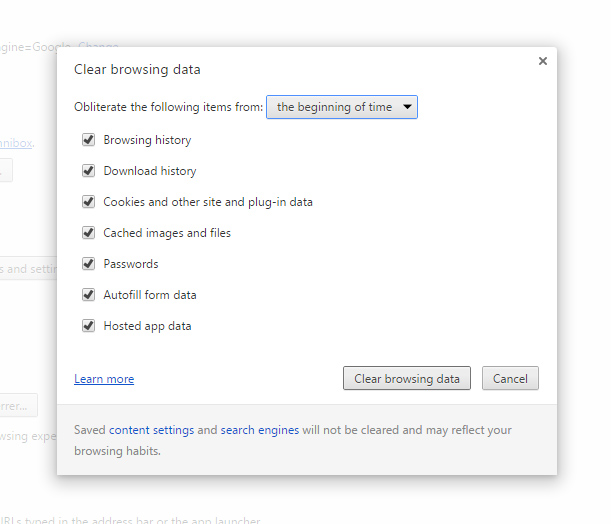Category : Opinion
I first came across WhiteHat Security’s Aviator Web Browser a few months back when my computer was infected with a kind of malware known as Svahszdifides.exe.
My computer was slow as hell, there were ads popping up on every web page I visited that didn’t belong to the sites I was visiting, and this thing was blowing out my bandwidth like crazy, opening dozens of port connections at a time, basically compromising everything on my system. Sometimes, I even lost control over web pages where dozens of pop-ups appeared. And every time I tried to erase it, it came back via copying itself over and over, right back into the same damn folder I’d been trying to erase it from.
Removing it was a real bastard – it took MANY attempts using tools like FileASSASSIN, Revo Uninstaller, RegEdit and a few others – but finally, it was gone along with many other malware and adware files, nearly 500 in total.
It took five days to manually remove them all, and along the way, my research turned up some interesting advice: to rid my machine of browsers like MS Internet Explorer, FireFox – and yes, even Google Chrome. Articles I was reading explained that these browsers were so full of security holes due to all their “partnerships” with other tools and the like that I may as well be surfing the Web on a board made of Swiss Cheese.
Enter WhiteHat Security’s Aviator Browser, which I can honestly say has prevented the problem from recurring, though not without some trade-offs.
Choosing a PROTECTED window versus an UNPROTECTED one is as easy as clicking on the menu icon at the far right of the URL bar – by doing so, you’ll get a menu with all sorts of goodies and jumping off points to configure the Aviator Browser. Note in the image below the menu icon is greyed out when the menu is active:
 Aviator uses PROTECTED windows by default, and Aviator blocks the setting of cookies by default as well. Note the little cookie icon in the image to the left, right next to the green PROTECTED status indicator.
Aviator uses PROTECTED windows by default, and Aviator blocks the setting of cookies by default as well. Note the little cookie icon in the image to the left, right next to the green PROTECTED status indicator.
Not allowing cookies to be set might keep the malware noise down to a dull roar, but it will take some getting used to. Some sites will ask you to enable cookies just for that site, and if the site is trustworthy, by all means, go for it. Using Aviator, some sites may behave a bit differently than you’re used to, and yet others might give you a real run for your money when you try to log on.
Because of cookies not being set, you will have to become far more intimately acquainted with your passwords and logons – and I mean memorize them. Aviator does NOT autofill these in protected mode, which for me was a pain at first, but in the end a good thing. I changed all my passwords and organized them mentally such that I could recall them, and suddenly I got things done much faster and was far more organized because I had no more excuses for forgetting them.
You’ll note that some sites are finicky about Aviator. One would be eBay, which gives me the boot sometimes when I try to log in, along with a message about how important their cookies are. But I notice that if I log in again from their sign in page, I am often logged in on the second or third try, without having to cave in to their cookie requirements.
 EBay’s pages often trigger Aviator’s protections, as you see in the image to the left. The cookie icon is shown along with another icon to its right that indicates that plugins are being blocked on this page. Gotta love eBay for a great demo of intrusive activities!
EBay’s pages often trigger Aviator’s protections, as you see in the image to the left. The cookie icon is shown along with another icon to its right that indicates that plugins are being blocked on this page. Gotta love eBay for a great demo of intrusive activities!
On another occasion when I attempted to log onto my bank’s website, I was not able to stay logged in. Somehow, a cookie from their site had hijacked the browser’s usual PROTECTED status and inserted itself into Aviator’s history. This was easy to resolve by “obliterating” my entire browsing history “from the beginning of time” as stated in Aviator’s internal dialog box under “Clear Browsing Data.” Yep, a sense of humor helps :-). Check out the image below:
I’ll mention here that Aviator’s internals do look one hell of a lot like Google Chrome’s, and Aviator does use Google as its default search tool, which you can see on the screenshot behind this content (toggle the content on & off by clicking the circle with the “+” at the top right of this page).
So, yes, there is some cross-pollination with Google, but overall it’s not a bad thing. For one, it means that Chrome users will have an easy time using Aviator, due to the similar interfaces for changing settings. Aviator’s “Disconnect Search” – a tool from Google – is tops, and I’ve always liked the Google interface for bookmarks, which is practically copy-pasted into Aviator. Just click the star shape to the right of where it says “PROTECTED” and you’re there.
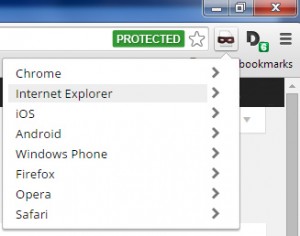 Next, you might be wondering what the little burglar mask icon and the big “D” just to the right of it are for.
Next, you might be wondering what the little burglar mask icon and the big “D” just to the right of it are for.
The icon with the little burglar mask is a spoofer, which allows the user to spoof – or mimic – many different browsers via Aviator. Clicking on the burglar mask icon gives the user the flyout menu depicted in the image to the left. Note all the different interfaces you can choose from, with versions of each when you click on the browser name.
FYI, spoofing can be used as a network management tool to reduce traffic, thus improving performance by preventing strain due to limits on bandwidth. It can also allow Aviator to fool websites into thinking it is a different browser altogether, which may make some operations easier.
 Next, that big “D” icon, which has a little green subicon with a number in it. The number represents the amount of requests that the visited website is making to the browser, whether they be ad-related, content-related or analytics-related…0r even social-related. When the big “D” is clicked, Aviator will fly out a box with details about them all. Neat, huh?
Next, that big “D” icon, which has a little green subicon with a number in it. The number represents the amount of requests that the visited website is making to the browser, whether they be ad-related, content-related or analytics-related…0r even social-related. When the big “D” is clicked, Aviator will fly out a box with details about them all. Neat, huh?
Overall, this browser called Aviator ROCKS. It does what I need – namely, to stem the onslaught of adware and malware infections, and I have no intention of going back to IE, FF or even Chrome at this point. Life with less aggravation = better health. It really is the little things like this, because they can sure pile up, given how much time we spend online these days.
Here’s hoping that Aviator stays as good as it is right now. It has its quirks and imperfections, but it has kept the chaos on my machine down to next to nothing. This has saved me valuable time spent ridding my system of malware and adware, time I can spend doing stuff I’d rather be doing, like writing blogs for one.
If you want to give Aviator a try, it can be downloaded here.
Yours in Stress-Free Computing and Great Health,
Alison
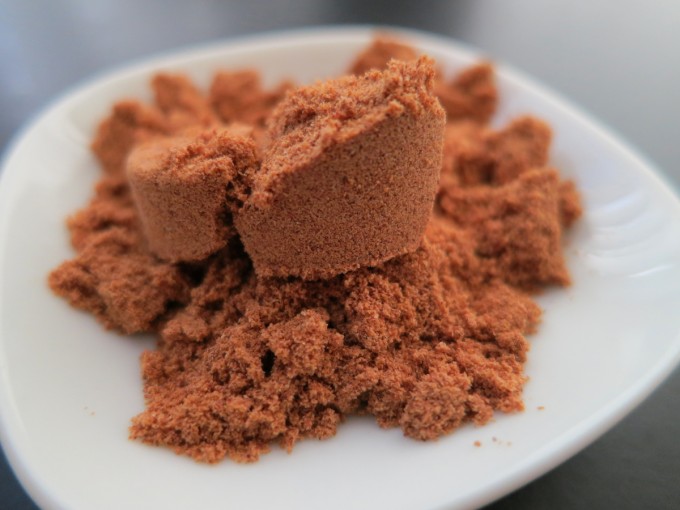
I first started eating fruit seeds some time ago after being told they contained beneficial and cancer-fighting substances like laetrile, which is found in apple and apricot seeds.
In 2012, while dealing with the nipple cancer lesion in my left breast, I came across a recommendation to use ellagic acid to help my body fight off tumors, my naturopathic MD in Los Angeles telling me that as long as I had enough antioxidants, I was protected.
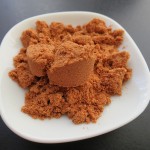 Ellagic acid is a naturally-occurring phenolic antioxidant contained in many fruits and vegetables, and had been recommended to me as being suitable for my needs. At first, I tried a supplement that combined ellagic acid with graviola, which had long been my standby for helping fight cancers.
Ellagic acid is a naturally-occurring phenolic antioxidant contained in many fruits and vegetables, and had been recommended to me as being suitable for my needs. At first, I tried a supplement that combined ellagic acid with graviola, which had long been my standby for helping fight cancers.
To my disappointment, the supplement didn’t agree with me – it was too concentrated for me at a time when I was also doing a very intense, year-long heavy metals detox on a three-days-on/four-days-off schedule using zeolite, cilantro and blue-green algae, including spirulina and chlorella.
The positive changes taking place in my body during this detox were nothing short of spectacular, and as bodies so often do, mine was changing. For the better. For me, it meant I had less and less use for supplements in general, including ellagic acid in concentrated supplement form.
In short: I needed to find something more food-like and body-compatible, rather than a refined and super-concentrated supplement.
I researched a little deeper and found that ellagic acid had precursors known as ellagitannins, that provide quite a bit more bioavailability in a much closer-to-nature form. That sounded good to me!
Enter Raspex Red Raspberry Seed Powder, made largely from a variety of the berry called Meeker Raspberries – those which contain the highest levels of ellagitannins that break down into beneficial ellagic acid in the body.
This is a powder made of finely-ground Meeker raspberry seeds, and is a beautiful berry color. Mixed with an avocado smoothie, it’s fantastic. Stirred into plain organic yogurt with a little stevia produces an almost parfait-like dessert item. I keep a container of it handy at all times and keep it refrigerated as recommended. I can think of no better way to get tons of beneficial antioxidants into my system.
That said, the powder is a bit hard to swallow by itself or with plain water – it does have some grit to it and unless it’s mixed into something, it can be rather scratchy. But that is a small inconvenience for the amount of antioxidants this lovely powder delivers into your system.
It has become a part of a regimen that includes Chinese and Naturopathic medicine, diet, herbs, exercise – pretty much all the things you’ll read on the My Cancer Protocol page on this site, which I update periodically. As always, do your own research and find what works for you!
I buy mine online from either SMDI or Amazon. It retails for around US $39.95 (or therabouts) and comes in a one-pound tub that can be popped right into the fridge upon arrival.
Yours in Great Health,
Alison
Today I’ve added the first page under a new section of the site, called “Top 10s,” where I include all my raves and faves. Today’s entry, Alison Lorraine’s Top 10 Fave Films, consists of reviews of my current Top 10 favorite movies of all time.
I’ll be filling the Top 10s section up with all sorts of goodies as I come across them, whether they be film or food or whatever form they may take.
Enjoy!
Yours in Great Health,
Alison
PS – Here’s a short teaser of just the first review you’ll see…
1 The Shawshank Redemption :: If life’s got you in a cage – of any sort – watch this film.Shawshank is ranked Number ONE on IMDB, which proves that the wisdom of the crowds trumps that of paid entertainment industry hacks who claimed it had the wrong tongue-twisting title, would never succeed because it was a prison film, an indie film, or this or that, all of it falling on the deaf ears of those whose good taste lifted it above the din of the so-called tastemakers…[more]

According to Vanity Fair, it is safe to believe again…I wonder if Deep Throat, the Lone Gunmen and Marita Covarrubias will show up 😉
[photo credit above: Vanity Fair – background photo: Alison Lorraine]
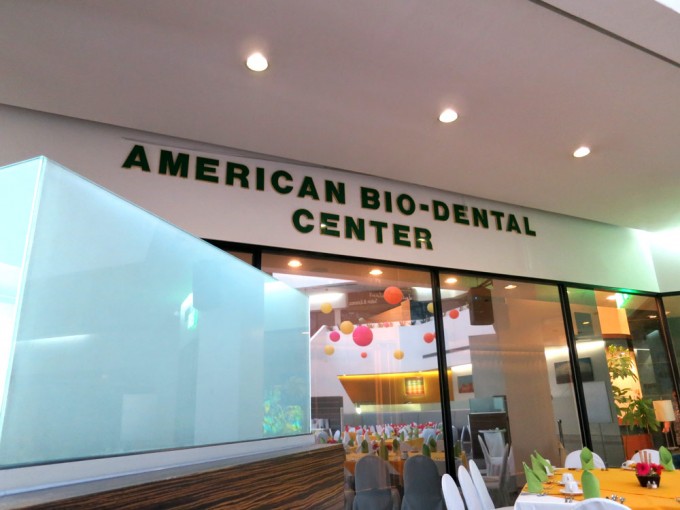
[This is a blog on my experiences travelling to and at American BioDental, a Mexican dental clinic specializing in holistic dentistry and alternative treatments for cancer, such as IV Vitamin C.]
While researching on treatment tactics for the breast lesion I was dealing with in 2012 and 2013, I found dental revision being recommended over and over as a foundation-level plank in the overall platform for beating cancer. Many self-directed cancer treatment sites even go so far as to say it may be enough in itself to clean up the dental environment to see big improvements, so my search was on!
Who knew this would be my view when I got there?

When looking around for a dentist to clean up the remaining mercury mess in my mouth, I sought four things:
- Simpatico. That whole feeling of likeability and ease of working together that is critical to any doctor-patient relationship, or should be. I’m not much of a yes-person and I sure don’t like being dictated to, then charged for it.
- Holistic. To a fault here, after years of having leaking mercury in my mouth, not by choice and which were never vetted as compatible with me…and, ummm, mercury isn’t compatible with…humankind.
- Qualitative. I wanted the best material my money could buy – and the least harmful, aka the most biocompatible. Anything being permanently placed in one’s mouth will certainly affect overall health. Profoundly.
- Affordable. I live in the US and own a body. Need I elaborate?
After much research and talking to various people, I chose American BioDental Clinic, located in Tijuana, Mexico. They hit favorable notes for all four of my requirements – whenever I called them, they happily explained everything and answered all my questions, including border-crossing options and then some. They specialize in holistic dentistry, including the removal of mercury, and I’d been in touch with several fellow survivors who’d gone there and reported success.
When I visited their website, I saw very reasonable pricing, and even more importantly, transparent and right out there for all to see. No having to call around and hear about payment plans that would have me in hock for years to come in the Great American Transfer of Wealth for what should be reasonably priced healthcare.
When I got to the Clinic, I saw that yes, their facilities were top-notch and yes, they used the best materials on the market for their patients – even encouraging them to get a biocompatibility test if they were dealing with cancer (my results).
After the initial intake and panoramic x-ray, I was told I had 23 teeth that needed work, including new fillings, replacement fillings, several inlays and a surgical mercury tattoo removal. Not being too much of a glutton for punishment, I arranged the work to be done in two parts – later that day, the right side of my mouth, top and bottom. Several weeks later, the left side. And then a third, very short visit for a quick follow-up on one problem tooth the dentists at the clinic saved with their excellent work, but told me to keep an eye on.
While under the drill, I also had Vitamin C IV drips – 50 grams each time – well-known to be extremely helpful for the immune system and a great treatment for cancer. Additionally, IV Vitamin C has the benefit of keeping re-exposure to heavy metals to a minimum while dental work is being done.
In my case, there were a lot of mercury tattoos left from half-assed amalgam removals not done safely or completely (but very expensively!) in the US back in 2008. After those, I’d thought – I’d hoped – that my problems were over. But they weren’t, as evidenced by ongoing cancerous lesions on my skin and left breast. Since there was still mercury residue in the form of grey-colored areas on my teeth and gums, along with loose fillings and cracks, the effects were still playing out in my system to my detriment.
Dental work and detoxes were in order, as soon as possible and within a reasonable budget, because it seems patients in the US are out of luck in getting mercury-related dental revisions paid for by the system that visited them upon us all. It would be akin to an admission that there was a problem, which I can only guess is a real no-no. It was only fitting that I took my business elsewhere.
So, on to the nitty gritty details about my trip(s) down under the USA’s southern border…
Crossing the Mexican border. I park and walk across, and for this, I take the 805 south to San Ysidro – the “LAST US EXIT” – the signs are very clear and say just that. At the end of the off-ramp, hang a right, go down the little hill, and what I usually do at the first intersection is make a right, then another quick right straight into a pay-as-you-go parking lot (cost, as of this writing: $7 per day). Park, and then you can either walk to the border crossing, or pay for one of the many rickshaws, etc., that come around looking to help out (plenty). I just walk it, it is not that far, and I don’t usually have more than a backpack.
Walking out of the parking lot toward the Mexican flag…which is right under the American flag in my pic…
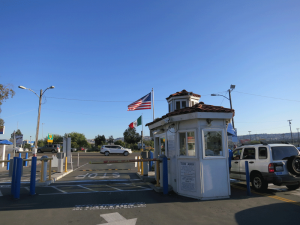

Once out of the lot, cross the street and hang a left to the intersection (pictured below), where you’ll cross the street using the crosswalk (shown below). After crossing, go straight…
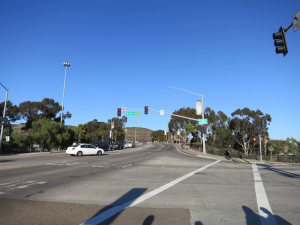
You’ll come to the pedestrian bridge that takes you back over the 805. You’ll see other people going where you want to go, so just follow them over the highway 🙂

You’ll come to a set of stairs, and at the bottom, go to the right and walk toward the train station area:

You’ll also see busses and lots of people, taxis and the like. The walkway to Mexico goes in between two buildings, then behind them and to the right. There’ll be plenty of others walking this route, and you’ll see this:
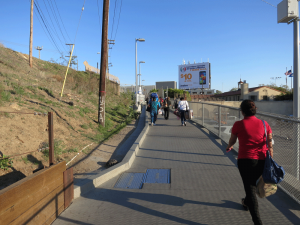
…and then you’ll see this…

…and you’ll realize that all the jokes are true: There really is a revolving door between Mexico and the US, lol! Two, in fact…
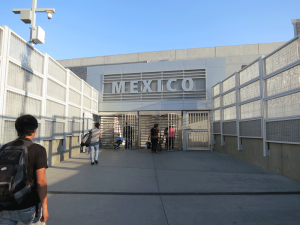
The revolving doors are the way to the “customs” area – and I put this in quotes, because it’s pretty basic – it is just a couple of revolving doors under the “MEXICO” sign (see the image above) that lead you into a small room where (sometimes) your bags are checked and (most of the time) you will see a member or two of the Mexican military standing guard as you exit.
After you exit customs, you’ll cross over the same highway in the other direction – and be warned, the path is just as circuitous as on the American side – to the taxi cab area. Per my previous advice, follow the crowd, they will lead you well. And note one of the first things you see on the Mexican side is a big pharmacy. Supply and demand. Go figure.
The taxi ride to the Grand Hotel Tijuana, where I usually stay when I have an appointment at American BioDental, is around $7 – 10, and takes around 10 minutes.
At the Grand Hotel Tijuana. This is a veeeerrrry niiiiiice hotel! You’ll pay the same for a shithole in LA, and with that, you’ll start to learn why over a million Americans call Mexico home, probably many of them “illegally.” The rooms are very nice and clean, have great bathrooms, and if you’re on one of the upper floors, you’ll have a fantastic view to boot. They have a very nutritious morning buffet, with complete proteins like eggs, chicken, beef, etc. You will not starve.

The water. Okay, had to get to this, and I’ll say this first: I drank the water freely on my first visit, and a few days later, had the most thorough and inexpensive full-body detox I’ve ever had. Otherwise known as Montezuma’s Revenge. Not very pleasant, but all-inclusive to a fault. The next few times I went, I was more careful, and I took a strong probiotic called Primal Defense with me. I think Saccharomyces Boullardi would also work well, just make sure to take enough of it. There is filtered water in the rooms, as pictured below:
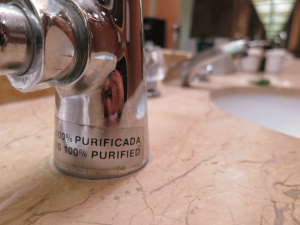
But…you know how it goes: Somehow, something always goes awry. The tea water isn’t quite boiled long enough to kill everything. Or, you brush your teeth and forget to use the filtered water. So I’m careful, and at restaurants, I usually order a mineral water called Ciel – it is canned and entirely (…uhhh, at least as far as canned drinks go) safe:
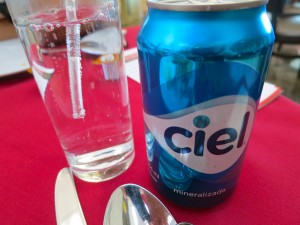
Going back to the US (do we have to?). One of the Alessandros, aka either American BioDental’s head doctor or his son, usually drives me and a few others back across the border. They usually leave once or twice per day, and this is VERY preferable to walking back across, as they have frequent crosser permits and it’s usually pretty painless. Take my word for it: Crossing into Mexico is a piece of cake. Crossing back into the US is an overblown exercise in paranoia. Go, and you’ll see for yourself.
Yours in Good Health,
Alison
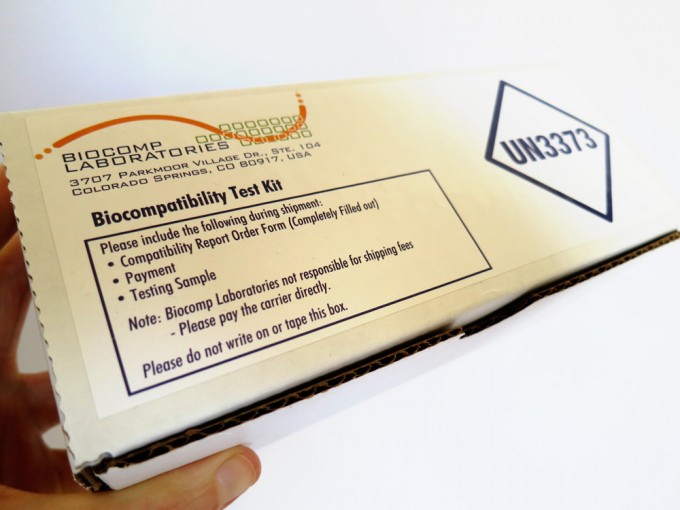
[This blog details heavy metal biocompatibility testing as regards dental materials placed in the body long term.]
In 2008, I had the last of my dental mercury fillings removed, which promptly put me back in intimate touch with my old standby, Big C. The connection between heavy metals and cancer is one I know very well, though it is also one that the mainstream medical system likes to say doesn’t exist, thus my recent excursion into finding and taking a blood serum test that told me whether or not I was mercury reactive based on scientific analysis.
The dental work itself was sloppy – leaving several mercury tattoos and a cracked tooth – and not following the recommended Huggins protocol for safe removal of heavy metals for me saw new melanomas cropping up over 2009, 10, 11 and 12, all capped off by the crowning event of late: a left breast cancer lesion.
As usual, I’m in it to win it. And along the way, gather as much proof along the way as I can, first for me and secondly for all those naysayers who think I’m off my nut for “believing” in heavy metals toxicity. It is not a question of belief, it is a question of testing to see if I’m reactive, how much toxicity is in my system, and then figuring out what to do about it.
While dealing with my left breast nipple lesion in 2012, I read some very interesting things about how teeth are connected to specific organs and systems in the body via meridians, as in Chinese medicine. No real surprise to me that the left breast corresponded tooth-wise with the upper left first molar, where, interestingly enough, a very noticeable mercury tattoo still lived on the tooth and gumline (see the dead set sexy pic of the interior of my mouth above where you’ll notice the grey-tinged areas above and on the tooth of concern). When I was a kid, this tooth developed a full-on hole on its inner surface on the gumline, which was filled by…drum roll, please…silver-mercury amalgam. As the American Dental Association declares on its website:
Dental amalgam is considered a safe, affordable and durable material that has been used to restore the teeth of more than 100 million Americans. It contains a mixture of metals such as silver, copper and tin, in addition to mercury, which binds these components into a hard, stable and safe substance. Dental amalgam has been studied and reviewed extensively, and has established a record of safety and effectiveness.
The FDI World Dental Federation and the World Health Organization concluded in a 1997 consensus statementi: “No controlled studies have been published demonstrating systemic adverse effects from amalgam restorations.” Another conclusion of the report stated that, aside from rare instances of local side effects of allergic reactions, “the small amount of mercury released from amalgam restorations, especially during placement and removal, has not been shown to cause any … adverse health effects.”
[Source: American Dental Association]
My response? My ASS.
And I’ll give you even more than that: a material safety data sheet on mercury (and here’s one on dental amalgam alloy). It took about 30 seconds on a wireless internet connection to find all these, so please read them for yourself and do your own research as well to see where your opinion falls on the ADA’s statement.
I’ve heard plenty of “it’s all in yer head, Sweetie” – enough for me to get into the habit of questioning everything that’s ever been said to me by a mainstream medical practitioner. In my experience, suggesting to a mercury-sensitive individual that mercury or other toxins aren’t possible culprits in chronic diseases (such as cancer) is like telling a peanut-allergic individual to get over it and have a Reese’s.
As well, the ADA hasn’t studied yours truly, and as someone who is sensitive to mercury (tested, yes) and who seems to have no problem retaining too much of it in my tissues (tested again – and a genetic predisposition, from what I’ve read regarding certain genotypes not being able to excrete metals efficiently), I have to ask: Who the hell paid the ADA to state such things?
Given my experience with insurance companies that refused to cover mercury removal (otherwise they’d get found out and have to do a whole lotta freebie dental revisions, I suppose), my trust in the ADA regarding the mercury toxicity issue doesn’t even register. Their interests and my interests are divergent – ne’er shall their paths cross – and science corrupted by money isn’t really science, and all that.
I first discovered there was a blood serum biocompatibility test for heavy metals in the form of dental materials when I started talking with the American Bio Dental Clinic in Tijuana, Mexico. They encouraged all their patients dealing with cancer to have one, and for me, it was a no-brainer as I’m always after proof of what is actually going on…not what someone “thinks” just by looking at me, aka the Bill Frist “diagnosis.” Only when I see the real deal picture can the action I take be accurate and effective.
The test recommended to me was the Biocompatibility Test Kit from BioComp Labortories in Colorado Springs, Colorado in the US of A, which American Bio Dental forwarded directly to me previous to my initial scheduled dental revision in Tijuana. The picture behind this blog post (toggle the content away and back by clicking the round button with the + or – sign in it) shows what the test kit’s box looks like, including the test number (UN3373) along with the lab’s address and simple instructions.
Contents of the test kit include paper work (a Compatibility Report Order Form, Lab Instructions, Patient Instructions, FAQs and a Request for Client Serum Sample). In addition, there is a styrofoam container with a serum tube, outer tube and two small freezer packs that must be frozen for serum shipment to the lab for testing.
After fasting overnight per the instructions, I took the kit first to LabCorps, which had this test in their system under the instructions “Do NOT Use – Pending” and could not do the blood draw. Then it was on to Quest Diagnostics, who happily did the test per the instructions. After the blood draw and my payment, Quest sent my kit directly to BioComp Labs for the analysis.
The total cost for this was as follows:
$350 Serum Biocompatibility Test (including shipping & compatibility report)
$41.80 Blood draw at Quest Diagnostics:
$391.80 – Grand Total (and note that this test was not covered by insurance – nor was I – at the time it was done in mid-November, 2013)
When I got the results back from BioComp’s Blood Serum Compatibility Test, I was not at all surprised. This is further validation for what several top-notch holistic medical pros claimed was a major factor in the health problems I’ve had.
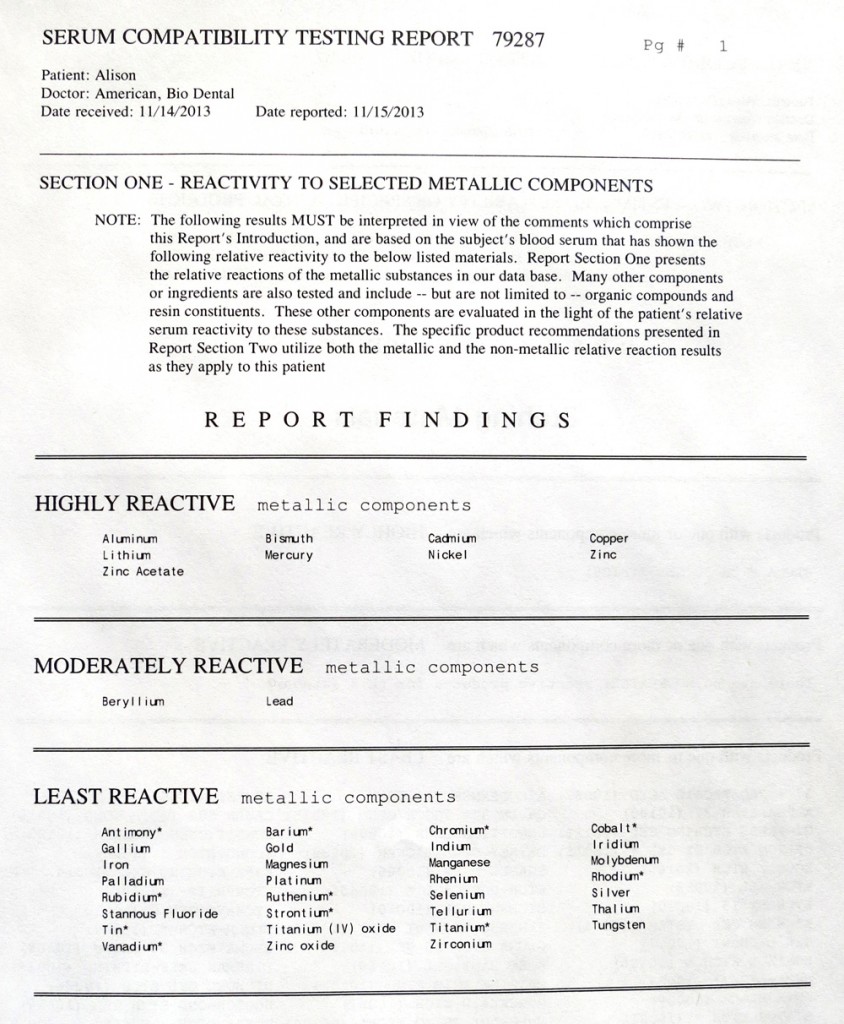
Page 1 from BioComp Labs’ report (see above image) contained a listing of dozens of metals used in various dental materials, separated by reactivity level in me as the subject tested via blood serum analysis.
As you can see for yourself above, in the Highly Reactive category was my old pal mercury and a few other heavy metallic malcontents, including nickel (petro fumes, cigarette smoke, cookware, etc.), aluminum (cans, foil, cookware, etc.), lithium, cadmium, copper…and even zinc and zinc acetate.
Of interest was bismuth, that ingredient in Pepto-Bismol (or Pink Bismuth if you’re going generic) that also showed up in the Highly Reactive category. I’m not sure what the full interpretation of this is, because Pepto-Bismol seems to work just fine for me (though I rarely use it, so that may be telling).
Silver and gold turned up in the Least Reactive category (of course, I’ve always had an affinity for those :-)). So did Titanium and Zinc oxides (used in sunscreens and other products), Stannous Flouride (toothpastes) and plenty of other metals.
This testing report also contains dozens more pages of thousands of dental materials, categorized as Highly, Moderately or Least Reactive. The American Bio Dental Clinic in Tijuana informed me they use a product called Diamond Crown for composites, fillings and inlays (most of the work I’ve had done by them), and this showed up in my report as being among the Least Reactive. That is good news! Anything that is permanently fixed in my mouth had better fall into that category, otherwise it’s yet another possible cause for the cancer cup to runeth over.
This brings me to some commentary on the dental industry as a whole, speaking from the experience of years spent down the hole on mercury toxicity and other issues that could have easily been prevented had my childhood dentist simply tested me for compatibility with dental mercury amalgam. The fact that at least a dozen amalgams were placed in my mouth without my knowing the possible effects – or even being given a choice in the matter – illustrates everything that is wrong with the mainstream medical system and its largely one size fits all mentality.
Considering that Romney-Obamacare doesn’t yet include this type of biocompatibility test as part of a larger preventative scheme, it needs revision – and soon. Having read that we are now exposed to more toxins in 15 minutes than our grandparents were over their whole lives makes lowering the body’s burden even more critical than ever.
Yours in good health,
Alison
PS – BioComp Laboratories can be found via www.biocomplaboratories.com and the American Bio Dental Clinic by pointing to www.americanbiodental.com. Ain’t research fun? Cheers…
[Contents of this post are for educational purposes only and all that jazz.]
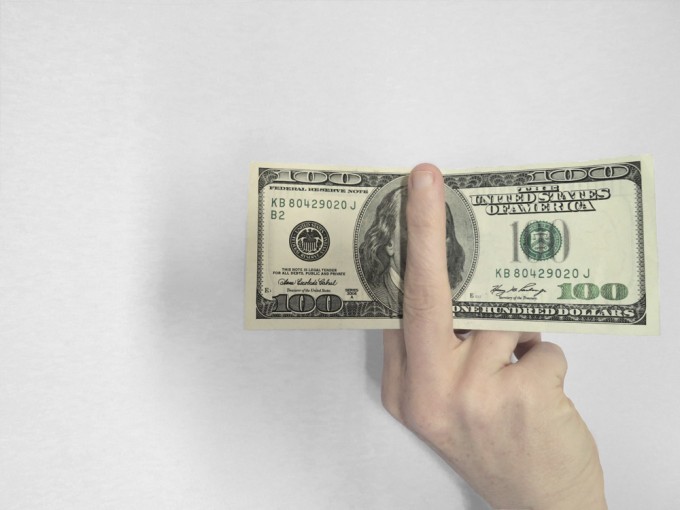
It was very fitting how I learned of Breaking Bad. A friend and fellow cancer fighter, whose own battle started with melanoma – and later, stage 4 prostate cancer and then some – told me about this cool new show he’d been watching. It featured a very smart, but very broke school teacher working two jobs…and he had lung cancer on top of it all. In other words, someone who’d had enough.
Ding.
He’d had it to the point where he’d started making and selling meth to pay medical bills and provide for his family…and to make up for the deficits he saw in his own existence.
Ding.
The main character of the show, one Walter Hartwell White, played to perfection by Bryan Cranston, had also felt the sting of the Big Fuck You Over Money via two former business partners, who’d become billionaires on the back of Walter’s chemistry genius after he left the company. He went near-broke, barely eking out a living as a schoolteacher moonlighting at the local car wash. And now, he wanted his cut of the Big Pie. However he could get it.
Ding! Ding, ding, ding-ding-ding-ding-diiiing!
As the description came out of my friend’s mouth, I was immediately hooked. One cancer survivor who’d been screwed over telling another about a show featuring yet another. There was a love triangle in there somewhere.
As I started to watch back episodes to catch myself up, I saw in Walter White shades of yours truly.
Firstly, cancer. The day of my diagnosis was a game changer. I was never the same. Never looked at things the same way again. Did some things I’m not proud of.
Most of the past years since my diagnosis, I’ve not had access to “the system.” Sometimes I had health insurance, sometimes not. Seeing as I prefer holistic healthcare and treatments other than those offered by Big Pharma-racketed US Sick’n’Pay, I think that was in many ways for the best. For me, it was a good thing not to have access to too many pharma drugs. All they ever did was crash my immune system, making me sicker with each pass. But not so good when I needed a decent and timely diagnostic. Or necessary surgery and dental care.
Secondly, career frustration. Majorly. Won VH1’s Song of the Year, twice. Sold over 100,000 units of my tunes, largely soundtrack and overseas indies. Still no big, life-changing deal, and way too many questions…but I sure found out what “several layers of record label accounting” really means.
Thirdly, financial devastation. Even working through the Big C for the Big Dream. Flashback to 2004. Three jobs. Made Bush proud! Lesson: ‘work hard and you’ll make it in America’ is a great soundbite, but don’t ask me to believe it after all I’ve seen and experienced. Proof in the form of a million-dollar music publishing deal would be far more convincing and practical.
LOL! Don’t laugh – that was my original goal in entering The Biz. That, and access to decent medical. Such was life in these United States.
But now, like Walter White’s ever-increasing monetary goals, mine, too, have grown. Because as anyone who’s experienced the Big Fuck You Over Money can tell you, it puts a fire under your ass. Because life should be more than chasing illnesses, mere survival and the constant mind-chatter of rotating what ifs.
The reason for Breaking Bad’s success is that it touched those same raw nerves in so many millions of others. We all want to Break Big. And some are willing to Break Bad to do it. I can certainly relate.
Which brings me to this point: Breaking Bad was damn close to perfect. So damn close to perfect. Vince Gilligan of X-Files fame made it perfect in every way, except for one little, BIG thing.
I think back to the episode where Walt’s doctor is discussing alternative treatments for cancer – and the off-the-main-drag-but-still-Pharma-biased doctor’s canned response came in like a rainstorm on a parade when he mentioned his uncertainty about the efficacy of such treatments.
So, yes, Hollywood manages to mention alternative treatments. But then there’s the suited Dr. Deus ex Machina, telling us all about a lack of efficacy associated with them.
Hmmmmm.
Anyone else smell the Big Pharma bucks behind that?
Because honestly, that hasn’t been my experience. In fact, just the opposite. Pharma drugs were what created my Big Mess in the first place. Treatments outside of those pushed on us by Big Pharma have largely gotten me back to some semblance of health. But I certainly am still chasing things down, given that FDA-approved drugs almost deep-sixed my skinny ass.
Thus my request to Hollywood: Why not come up with a show that follows a cancer-fighting character, preferably someone who, in “real life,” has or had the disease – WE need the money. And please, make the protagonist someone using alternative, holistic medicine – if alternative even applies to treatments existing thousands of years B.C., aka Before Chemo. Make it a story about someone for whom the system has failed, who realizes the only way out is to Break Brave and follow his or her gut instincts. Kinda like I – and a lot of others – had to.
When – IF – Hollywood Breaks Brave (and decides to go truly free market where cancer treatments are concerned), I’ll be all-in. A 100% FAN! Behind-the-scenes experience tells me that many celebs use alternative, holistic healthcare, but still do and say whatever their corporate paymasters order them to do and say for a paycheck.
Tragic. And certainly not role model material.
When both Hollywood and doctors serve as guides, not gods – and no longer serve Big Pharma to the exclusion of all else over money – that will be the day. And if the day comes when I see universal, single-payer, sliding-scale healthcare featuring a full set of choices for cancer treatments in America, I’ll be first in line.
Yours in Great Health,
Alison

